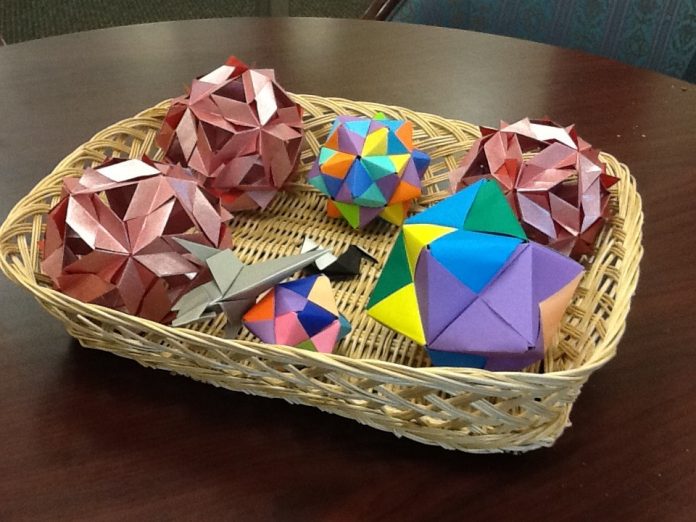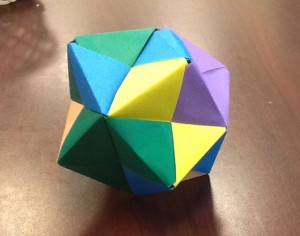 Sophomore Bruno Brenes ’15 has found a way to turn paper into water. No, he’s not a Hogwarts wizard performing transfiguration spells. He’s something even better—an Origami Master.
Sophomore Bruno Brenes ’15 has found a way to turn paper into water. No, he’s not a Hogwarts wizard performing transfiguration spells. He’s something even better—an Origami Master.
A few months ago, Brenes started up Jesuit’s first origami club. Prior to this, he had been working for the Paper for Water charity, an organization that creates and sells origami to help build water wells for those in developing countries. Noticing how hard volunteers had to work around the holidays when demand is highest, Brenes thought he could do something to help them out and lessen their load. So, he decided to create the Jesuit Origami Society, with Mr. Rich Perry as club moderator.
Bruno completely “learned on [his] own. I used books and YouTube videos. My mom tells me they used to teach it to us in Kindergarten, but I don’t remember…I just got a book called ‘Origami to Amaze and Astonish’ by Jeremy Shafer, and I got hooked. After that, I just learned diagram after diagram.” Eventually, he decided to share his love of origami with the Jesuit community for a good cause, leading to his establishment of the Society.
The Jesuit Origami Society started with one member. Then, at the first meeting, three people joined. The next meeting, three more joined. Now, the club has twelve committed members, along with a few others who attend periodically.
Brenes, an origami master, gives weekly training sessions, so anyone can come to the meetings. He encourages those of all skill levels to try out the club, explaining that “in today’s wo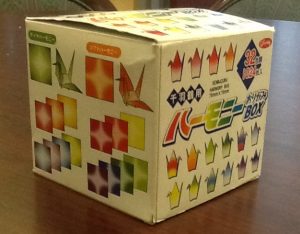 rld we are very comfortable being cozy, while a large part of the world doesn’t even have easily accessible clean water. Origami is relaxing and easy to make (most of the time), and if you can help the world while doing it, then the real question becomes why not do it? And I can almost promise you there are no reasons. Time is as good a donation as money.”
rld we are very comfortable being cozy, while a large part of the world doesn’t even have easily accessible clean water. Origami is relaxing and easy to make (most of the time), and if you can help the world while doing it, then the real question becomes why not do it? And I can almost promise you there are no reasons. Time is as good a donation as money.”
The club creates origami artwork, and Brenes decides which ones best fit the description of what Paper for Water needs. Then, he delivers them to the local Paper for Water group, which meets at the Perot Museum of Nature and Science on Saturdays. They take them and sell them, depositing the money into one account (Living Water) that finances water wells, mainly in India.
Many people use the origami as decoration for the holiday season. Pieces can sell anywhere from $10 – $50, but the majority are in the $20 – $35 range. These prices range because of effort or quality; however, for the most part, people make donations and receive origami models in return as tokens of appreciation.
The Jesuit Origami Society meets for “folding parties” twice every Wednesday: during fifth period (sophomore) lunch and after school. This is strategic, so that projects started during fifth period can be finished later at the end of the day.
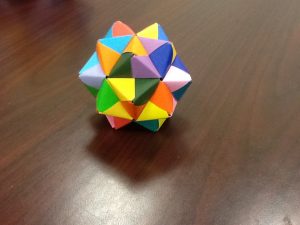 Members can sometimes even receive service credits for their efforts. Perry asserts that credit is given “when the club does something special. There is a special objective, when we need to rapidly produce a lot of product. Students might get one service credit if they spend a considerable amount of time working on that project. The other time when service credit could be given is when the Perot Museum itself calls us and says they really need the extra help on a Saturday.”
Members can sometimes even receive service credits for their efforts. Perry asserts that credit is given “when the club does something special. There is a special objective, when we need to rapidly produce a lot of product. Students might get one service credit if they spend a considerable amount of time working on that project. The other time when service credit could be given is when the Perot Museum itself calls us and says they really need the extra help on a Saturday.”
Perry is living proof that anyone can pick up origami. Though experts such as Bruno can create a masterpiece in half an hour, it doesn’t mean that neophytes can’t learn to construct their own artistic crafts; it just requires extra time and patience.
Though Perry sponsors the Society, he admits that he is “by no means an expert in origami,” adding that he is “definitely a novice.” He continues, explaining that he “send[s] a signal to people that it is okay to be a beginner. I think a lot of people are fearful to start something new, and I think that by seeing a teacher giving it a shot . . . it encourages people. So I see my role as setting the example of it’s okay to learn a new thing. It’s a moderate level o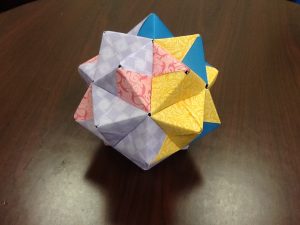 f difficulty. Anyone can make origami, if they have the right attitude. And the attitude is a sense of openness, an attention to detail, a willingness to listen to the instructions that the teacher is giving.”
f difficulty. Anyone can make origami, if they have the right attitude. And the attitude is a sense of openness, an attention to detail, a willingness to listen to the instructions that the teacher is giving.”
The club is going strong and is very active, yet Brenes and Perry are still looking for ways to expand the Society’s impact. Brenes mentioned that “it’d be great of we could reach somewhere close to 30-40 [members] by the end of the year.”
Perry “envision[s] that it is all going to happen organically by word of mouth, because so far the guys are really enjoying the experience,” adding that he doesn’t even “feel a need to promote it because it is self-promoting.”
Right now, the leaders are considering offering the club two days a week after school for the 2014-2015 school year. There are also some conversations about a couple Saturdays during the summer when the group would meet at the Perot Museum and do some more work there.
The Jesuit Origami Society is a wonderful way for creative students to express themselves while at the same time contributing to a great cause. Looking for a new club that combines service, art, and pizza? Look no further. The Jesuit Origami Society will welcome your help, whether you are a freshman or senior, an origami beginner or master.


